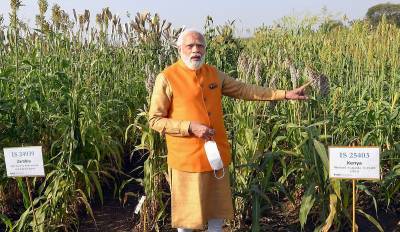NEW DELHI, 15 March 2024: The central government has launched several schemes and initiatives in recent years to support the farmers and improve the agricultural sector in India.
These policies aim to address the various challenges faced by the farmers, such as low productivity, high input costs, market inefficiencies, climate change, and natural disasters. They also seek to promote sustainable and profitable farming practices, enhance food security and nutrition, and boost rural development and income. In this report, we review some of the major policies and their impacts on the farmers and the agricultural sector.
One of the flagship schemes of the central government is the Pradhan Mantri Kisan Samman Nidhi (PM-KISAN), which provides income support of Rs 6,000 per year to all eligible farmer families in three equal instalments [1]. The scheme was launched in February 2019 and has benefited more than 12 crore farmer families so far [2].
The scheme aims to supplement the income of the farmers, especially the small and marginal ones, and help them meet their various needs and expenses. The scheme also enables the farmers to invest in improved inputs and technologies, and adopt better farming practices.
Another important scheme is the Pradhan Mantri Fasal Bima Yojana (PMFBY), which provides crop insurance to the farmers against losses due to natural calamities, pests, and diseases [3]. The scheme was launched in January 2016 and has covered more than 29 crore farmers and 58 crore hectares of cropped area so far [4].
The scheme provides comprehensive risk coverage, low premium rates, timely claim settlement, and use of technology for assessment and monitoring. The scheme aims to protect the farmers from the uncertainties of weather and markets, and provide them financial stability and security.
The central government has also introduced the Pradhan Mantri Krishi Sinchayee Yojana (PMKSY), which aims to enhance the irrigation coverage and water use efficiency in the country [5]. The scheme was launched in July 2015 and has covered more than 10 crore hectares of irrigation potential so far.
The scheme has four components: Accelerated Irrigation Benefit Programme (AIBP), Har Khet Ko Pani (HKKP), Per Drop More Crop (PDMC), and Watershed Development (WD). The scheme aims to provide water to every farm, improve water productivity, and promote integrated water management.
The central government has also launched the Soil Health Card Scheme, which provides soil health cards to the farmers with information on the nutrient status and fertilizer recommendations for their soil. The scheme was launched in February 2015 and has issued more than 23 crore soil health cards to the farmers so far. The scheme aims to improve the soil health and fertility, reduce the cost of cultivation, increase the crop yield and quality, and promote balanced and judicious use of fertilizers.
The central government has also initiated the National Agriculture Market (e-NAM), which is an online trading platform for agricultural commodities. The scheme was launched in April 2016 and has integrated more than 1,000 mandis across 18 states and 3 union territories so far. The scheme aims to create a unified national market for agricultural produce, enhance the transparency and competitiveness of the trade, reduce the intermediaries and transaction costs, and ensure better price discovery and realization for the farmers.
The central government has also implemented the Agricultural Property Relief, which extends the existing scope of agricultural property relief to include all environmental land management schemes, such as the Sustainable Farming Incentive, Countryside Stewardship, Landscape Recovery, and England Woodland Creation Offer. The scheme was announced in March 2024 and will be effective from April 2025.
The scheme aims to encourage the farmers and landowners to take part in the environmental schemes, and exempt them from the relevant inheritance tax. The scheme also removes the barrier for tenant farmers and landlords to collaborate on the environmental schemes.
These are some of the key policies and initiatives of the central government for the farmers and the agricultural sector. These policies have had positive impacts on the income, productivity, resilience, and sustainability of the farmers and the sector.
However, there are also some challenges and gaps in the implementation and outreach of these policies, such as the lack of awareness, access, and participation of the farmers, the delays and discrepancies in the fund transfer and claim settlement, the inadequacy and inconsistency of the data and technology, and the coordination and convergence of the various schemes and stakeholders.
Therefore, there is a need for more effective monitoring, evaluation, and feedback mechanisms, as well as more inclusive and participatory approaches, to ensure the successful delivery and impact of these policies.
Sources: 1, 2, 5] gov.uk, 3] pib.gov.in, 4], static.pib.gov.in
Image credit: PTI























